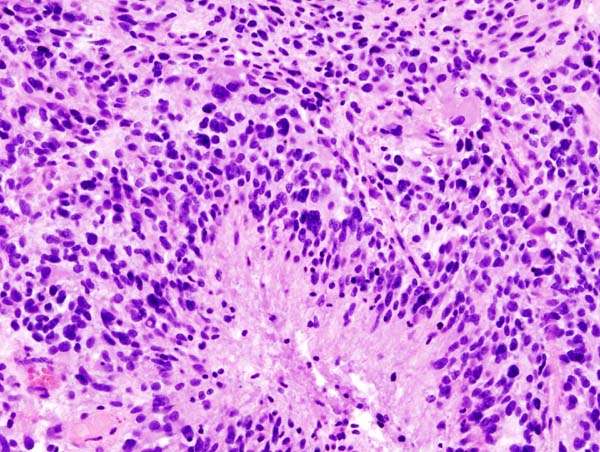Glioblastoma multiforme pathophysiology: Difference between revisions
Jump to navigation
Jump to search
| Line 9: | Line 9: | ||
* Almost all cases of GBM are sporadic, without a familial predilection, although [[chromosome|chromosomal]] aberrations such as [[PTEN (gene)|PTEN]] mutation, and [[p53]] mutation are commonly seen in these tumors. | * Almost all cases of GBM are sporadic, without a familial predilection, although [[chromosome|chromosomal]] aberrations such as [[PTEN (gene)|PTEN]] mutation, and [[p53]] mutation are commonly seen in these tumors. | ||
* Growth factor aberrant signaling associated with [[Epidermal_growth_factor_receptor|EGFR]], and [[PDGF]] are also seen. | * Growth factor aberrant signaling associated with [[Epidermal_growth_factor_receptor|EGFR]], and [[PDGF]] are also seen. | ||
===Associated Conditions=== | |||
Glioblastoma may be associated with:<ref name=ddd>Pathology of glioblastoma multiforme. Dr Dylan Kurda and Dr Frank Gaillard et al. Radiopaedia 2015. http://radiopaedia.org/articles/glioblastoma</ref> | |||
*Neurofibromatosis type 1 | |||
*[[Li-Fraumeni syndrome]] | |||
*[[Turcot syndrome]] | |||
*[[Ollier disease]] | |||
*[[Maffucci syndrome]] | |||
===Gross Pathology=== | ===Gross Pathology=== | ||
Revision as of 17:49, 12 September 2015
|
Glioblastoma multiforme Microchapters |
|
Diagnosis |
|---|
|
Treatment |
|
Case Studies |
|
Glioblastoma multiforme pathophysiology On the Web |
|
American Roentgen Ray Society Images of Glioblastoma multiforme pathophysiology |
|
Risk calculators and risk factors for Glioblastoma multiforme pathophysiology |
Editor-In-Chief: C. Michael Gibson, M.S., M.D. [1]
Overview
Pathophysiology
Genetics
- Almost all cases of GBM are sporadic, without a familial predilection, although chromosomal aberrations such as PTEN mutation, and p53 mutation are commonly seen in these tumors.
- Growth factor aberrant signaling associated with EGFR, and PDGF are also seen.
Associated Conditions
Glioblastoma may be associated with:[1]
- Neurofibromatosis type 1
- Li-Fraumeni syndrome
- Turcot syndrome
- Ollier disease
- Maffucci syndrome
Gross Pathology
Microscopic Pathology
References
- ↑ Pathology of glioblastoma multiforme. Dr Dylan Kurda and Dr Frank Gaillard et al. Radiopaedia 2015. http://radiopaedia.org/articles/glioblastoma
